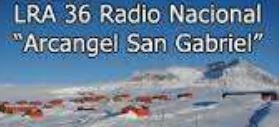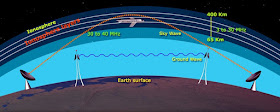Welcome to Teak Publishing's Shortwave Central blog. This blog covers shortwave frequency updates, loggings, free radio, international mediumwave, DX tips, clandestine radio, and late-breaking radio news. Visit my YouTube and Twitter links. Content on Shortwave Central is copyright © 2006-2026 by Teak Publishing, which is solely responsible for the content. All rights reserved. Redistribution of these pages in any format without permission is strictly prohibited.
Pages
Saturday, October 31, 2020
From the Isle of Music and Uncle Bill's Melting Pot schedules, November 1-7
Friday, October 30, 2020
Listener’s Day on Radio Romania International
Thursday, October 29, 2020
Weekly Propagation Forecast Bulletins
Product: Weekly Highlights and Forecasts
Antarctica slated to replay programming from Oct. 20
Broadcasting on 15476 USB, as reported on Twitter by Adrian Korol, RAE Director. LRA 36
will be on air next Saturday, October 31, 1500-2000 UTC repeating the 41st Anniversary program from October 20, 2020.
This is another chance to get the special 41st Anniversary eQSL from the station.
Radio Emma Toc World Service, November schedule summary
Encore-Classical Music from Radio Tumbril
10:00 - 11:00 UTC Saturday 6070 kHz Channel
292 to Europe - Simulcast on 9670 kHz
Repeated:
01:00 - 02:00 UTC Sunday 5850 kHz, Simulcast on
5010 kHz WRMI to the US, Canada and Central America.
17:00 – 18:00 UTC Sunday 9670 kHz Channel
292 to Europe
22:00 -
23:00 UTC Sunday 3955 kHz Channel 292 to
Europe
02:00 – 03:00 UTC Monday 9455 kHz WRMI to
the US and Canada
13:00 -
14:00 UTC Tuesday 15770 kHz WRMI to Europe,
east coast of US and Iceland.
03:00 -
04:00 UTC Thursday 5800 kHz WRMI to South
America and Caribbean.
13:00 -
14:00 UTC Thursday 15770 kHz WRMI to Europe,
east coast of US and Iceland.
20:00 – 21:00 UTC Friday 6070 kHz Channel
292 to Europe (Beginning 30th Oct.)
The website
is www.tumbril.co.uk where
we show transmission times and frequencies, the playlist for the most recent
programme, more information about Radio Tumbril, and the email link.
The programme finishes with an aria from Madame Butterfly, the Sanctus from Fauré's
Requiem and part of Sheherazade by Rimski-Korsakov.
A very good
site for online SDR receivers all over the world is: http://kiwisdr.com/public/ Click
the 'Map' button in the top left of the screen.
Shortwave Radiogram schedules, Thursday-Sunday
Largest Whale Stranding in the History of Tasmania: The Local Radio Scene
The largest stranding of whales in the history of the island of Tasmania, and in fact, the largest in the history of all of Australia, occurred in the middle of the month of September 2020. According to international news reports, a total of 500 whales were beached off the west coast of Tasmania; more than 400 have died, and around one hundred have been pulled, pushed, and cajoled back into deeper waters.
Local authorities and interested citizens have been working nonstop to save as many of those whales as possible. Those that are dead are towed out to sea and abandoned, or in some cases, they are buried in nearby sandy beach areas.
Although the 500 count is the largest mass stranding of whales in Australian waters, it is not a record elsewhere in the world. Back in 1918, a total of 1,000 whales were stranded off the coast of the Chatham Islands in the South Pacific. Even to this day, science does not understand why Pilot Whales are led to beach themselves in shallow waters.
The whales that are involved in this Tasmanian event are all Pilot Whales, one of the largest whale species. They were named Pilot Whales because each pod, or group of whales, seems to have a leader, or pilot, that leads them through the waters. They can be as long as 25 feet, they can weigh as much as 1¼ tons, they can live up to 60 years, and they eat squid and other types of fish.
The location on the west coast of Tasmania where all of these recent whales were stranded was near Macquarie Heads, on the ocean side of the peninsula that separates the Southern Ocean from Macquarie Harbour. The main highway running from the center of the island of Tasmania towards the central west coast runs through a very rugged mountainous country, and some people might even describe this highway as a dangerous highway.
The island called Tasmania is located south of the mainland state of Victoria, and it is shaped in the form almost of an equilateral triangle, 200 miles on each side. Near the central west coast, there are three main towns arranged almost in a triangle, with Queenstown as the largest and most dominant.
The first mediumwave station in Queenstown was 7QT which was inaugurated under test broadcasts on May 29, 1937, with 100 watts on 900 kHz. Two days later on Monday, May 31 (1937), local dignitaries assembled for an official opening ceremony.
The original transmitter was designed by Engineer S. V. Sydes and constructed with the use of Australian and American components in Launceston northern Tasmania in association with mediumwave station 7LA and the Stromberg Carlson radio company. This transmitter was tested on air in Launceston at 900 kHz three weeks in advance of the inauguration date in Queenstown.
The original location for the new 7QT in Queenstown was in the then seven-year-old Paragon Theatre at 11 McNamara Street. Soon afterward, the station was transferred into a temporary building at 89 Conlan Street in South Queenstown, and then into a newly constructed permanent building.
However, it was soon discovered that the local reception of 7QT on 900 kHz was disturbed by interference from the one thousand miles distant radio station 2LM at Lismore in New South Wales, and so eighteen months after its inauguration the operating channel for 7QT was changed from 900 kHz to 680 kHz. After a sequential change in a couple of frequencies and power levels, the callsign of 7QT was changed to 7XS on October 1, 1986. Four years ago (2016), 7XS dropped their usage of mediumwave, and they operate now on FM only in Queenstown, and also in the neighboring towns of Strahan and Roseberry.
A government-operated mediumwave station 7QN with 2 kW on 1540 kHz was installed in a lonely area a little north of the Queenstown airport on the western side of Zeehan Highway in 1954. Back a hundred years ago, the three cities, Hobart, Launceston, and Zeehan with its two-mile-long main street, were the thee major cities in Tasmania, though these days Zeehan is little more than a ghost town. The callsign 7QN was changed to 7RN in 1991, and ABC programming on two FM channels is available these days in all three of the major towns near the west coast; Queenstown, Zeehan, and Strahan.
Let's go back to the story of the commercial station 7QT. This mediumwave radio broadcasting station is remembered in Australian radio history for its claim to fame in three different areas of interest. When it was inaugurated in 1937, 7QT was acknowledged throughout Australia in the following three areas:-
1. Smallest radio broadcasting station in size with just 3 staff, and with the lowest income potential.
2. The most difficult mediumwave station anywhere in Australia to log, due to its location in a mountainous valley, with the bare, mineral-rich surrounding mountains interfering with the radiated signal, together with the low transmitter power. It was almost impossible to hear this mediumwave radio station even in other areas of Tasmania itself.
3. The first manager of 7QT was the 38-year-old Miss Irene S. Wedd who was the first female radio station manager anywhere in Australia.
Several issues of the WRTVHB state in the entry for 7QT that reception reports were not wanted. However, in spite of that announcement, QSL cards were always readily available from 7QT, and the earliest cards were always signed by Irene Wedd herself.
We began this radio article with the story of 500 whales stranded on the west coast of the Australian island of Tasmania. We conclude this radio article with another animal story from the same island of Tasmania.
The small and very vicious animal known as the Tasmanian Devil almost became extinct in the latter colonial period. The Tasmanian Devil is the size of a small dog, it is a loner, and its powerful jaws can break and chew animal bones, and it can bite through a thick metal fence. Their raucous scream is just as strong as their jaw.
Two hundred years ago, the Tasmanian Devil was identified scientifically as Sarcophilus satanic, meaning Satanic Fleshlover. This animal is described scientifically as a marsupial.
After 21 days, a baby Devil is born with a weight of just .007 of an ounce and it then moves into its mother's pouch in the same way as the baby kangaroo and wombat. There can be up to four young ones in the pouch, though even there they will fight and kill.
The Tasmanian Devil is a tourist attraction in Tasmania, and the government of Tasmania has established a breeding program for the conservation of the species. At the end of September (2020), a small colony of Tasmanian Devils with radio collars attached was released in a protective environment near Sydney on mainland Australia.
(AWR Wavescan-NWS 609) photo via radio heritage
Wednesday, October 21, 2020
SAQ Grimeton to broadcast October 24
Sunday, October 18, 2020
Encore-Classical Music on Radio Tumbril
Regular Broadcast times of Encore are:
Antarctica special programming October 20
Thursday, October 15, 2020
Honoring CAN Force Radio CAE with special programming
Monday, October 12, 2020
Weekly Propagation Forecast Bulletins
Saturday, October 10, 2020
From the Isle of Music & Uncle Bill's Melting Pot schedules
Friday, October 09, 2020
Encore - Classical Music on Radio Tumbril
Shortwave Radiogram schedules, Friday-Sunday
Thursday, October 08, 2020
Radio Taiwan International slated for Special Live National Day
Monday, October 05, 2020
The FCC Will Vote This Month on All-Digital AM
Radio Free Asia announces new QSL card now available
Current summer RFA schedule, effective to 24 October 2020
Burmese
0030-0130 12120 15110 15700
1230-1330 7530 9370 11805
1330-1400 7530 11805 12140
1400-1430 7530 11805
Khmer
1230-1330 9700 12140
1430-1500 9355 12140
2230-2330 9890 12140
Korean
1000-1100 1566
1500-1700 1188 9850 9990 11985
1700-1900 1188 9990 11985
2100-2200 9540 11945 11985
Lao
0000-0100 9940
1100-1200 15195
Mandarin
0300-0400 11570 11895 11985 17690
0400-0500 11895 13750 17690 21505
0500-0600 11895 17690 21690
0600-0700 11895 13790 17690 17810
1500-1600 9940 11675 13810
1600-1700 7540 11610 13570 13810
1700-1800 9360 9970
1800-1900 9360 9970 11745
1900-2000 1557 9360 9720
2000-2100 1557 6080 9360 9535
2100-2200 1557 7435 9685
2300-2400 9535 9720 15555
Tibetan
0100-0200 9370 9510 9705 11705 13765
0200-0300 9370 11705 11745 13765 *FNP
1100-1200 13580 15265 15470 17640
1200-1300 11570 13580 15470 17690 17720
1300-1400 11570 13835 15275 15470 17860
2300-2400 5965 9555 9875
Uyghur
0100-0200 9350 9780 9800 11640 11790
1600-1700 9355 9480 11675 15700
Weekly Propagation Forecast Bulletins
Friday, October 02, 2020
Encore-Classical Music on Radio Tumbril
Dear listener,






















